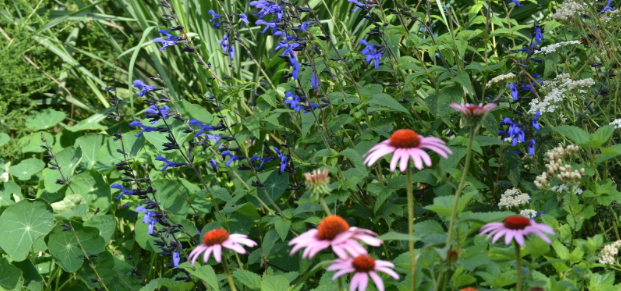Perennials in the Fall Garden

When it comes to gardening, it’s a well known fact that every gardener has their own way of doing things – and that’s okay! But it does mean that sometimes experienced gardeners send conflicting messages to newcomers about when, and how, to approach seasonal tasks in the garden. This October we’re looking at perennials in fall: what they are, how they behave, and different reasons gardeners may choose to cut cut back their perennial plants in now, or wait till spring.

What is a Perennial?
Perennials are plants that come back year after year, producing new stems, leaves and flowers each growing season only for the above ground portions to die back during the winter months. Daylilies, peonies, purple coneflower and hostas are all examples of perennial plants commonly found in St. Louis gardens.
When Should I Cut Back my Perennials?
The first rule of fall garden clean-ups: unless something is seriously diseased, wait for it to starting dying back before you cut back! The cooler temperatures of fall signal to trees, shrubs and perennials to begin preparing for winter, starting by storing up food and energy. Many plants will actually start this process by pulling nutrients out of their leaves and stems, moving them down into their root system to be used as fuel throughout the winter. This is what causes our plants to “dieback” in stages over a period of weeks each fall. By waiting until plants have died back to clear them from the garden, gardeners are ensuring a stronger, healthier plant will return next spring.
Best Practice for Cutting Back Perennials:
Although there will always be exceptions, most perennials do best when gardeners cut them back to approximately 1 inch above soil level, and remove the dead plant material from the area. This prevents gardeners from accidentally damaging shallow roots while cutting and the remaining stems also serve as “I am here!” markers for anyone mulching, digging, or planning to add plants to existing beds in the following year.
Not sure if you should cut back a specific plant? Swing by your local garden center to ask about best practices in your neighborhood, or send us your questions at [email protected]!
3 Reasons to Cut Back Perennials in Fall:
Reduce Problems with Pests & Diseases Next Year
It’s a well known fact that the biggest challenge in gardening isn’t necessarily getting things to grow. Sometimes, it’s all a gardener can do to prevent pests and diseases from hijacking the harvest! Despite not being food crops (usually) ornamental perennial plants are still susceptible to a range of diseases, insects, and other pests that can leave plants looking lackluster or downright unhealthy by the end of the year. By cutting back and removing dead leaves and stems, gardeners can encourage healthy new growth the following spring without the risk over overwintering a garden menace.
Drop by the University of Missouri Extension to learn more about preventing disease in the garden.
Tip: Bare soil often becomes compacted and loses much of it’s surface nutrients as winter snows and rains leach them away. To protect your soil, cover bare areas with a 3-4 inch layer of compost or plant a cover crop such as annual rye grass in fall.
Maintain Plant Size
Some perennials (and many ornamental shrubs) can grow to impressive sizes over the course of a single summer – and keep growing the following year. Prevent plants from outgrowing their space by cutting them back during the fall when there’s less risk of shock or attracting pests!
A Tidy Appearance
Gardens bursting with crops and stunning flower displays in summer give way to withered stalks and wilted leaves in fall – something that isn’t always appreciated by the neighbors. If your garden is in a public or highly visible space, consider cutting back perennial plants as they die back to keep your garden looking well-maintained and cared for to earn a little good will from the neighborhood.
Looking for a way to keep things looking tidy without cutting back everything? Try removing a few things at a time, then stepping back to check the overall effect. We recommend starting with peonies, daylilies and hostas while leaving hydrangeas and coneflowers for last. For best results, cut back to 1 inch above the soil level.
3 Reasons to Leave Perennials Standing in Fall:
A tidy garden may be aesthetically pleasing to the surrounding neighbors, but there are several benefits to leaving dead stalks and leaves in the garden over winter.
Winter Shelter for Local Wildlife
One of the downsides of living in an urban environment is the lack of habitat for local wildlife, and this can be especially challenging during the winter when small animals are most in need of shelter from wind and predators. For gardeners aiming to encourage and support local wildlife populations, waiting to cut back perennials until spring can provide additional cover and shelter.
Looking for a good reference to building a wildlife-friendly garden habitat? Check out this excellent guide by Penn State Extension Service.
Winter Food Source for Local Wildlife
Thanks to the Grow Native campaign, more and more of the perennials we see around St. Louis community gardens are actually native plants, such as purple coneflower, and they provide more than colorful seasonal interest. Many native species also serve as a valuable food source for local wildlife throughout the winter months – if you leave the dried seedheads and berries intact. Black-eyed Susans, purple coneflowers, and sunflowers are some of the most common plants we find in gardens that we recommend letting stand.
Looking for ways to add natural food sources to the garden? Stop by the National Wildlife Federation and the Missouri Botanical Gardens to learn more.
Winter Interest
Winter is a beautiful season in its own right, but by the time January rolls around the lack of visual interest found in many modern landscapes can leave gardeners feeling dull. Give your garden a bit of visual interest this winter by leaving perennials with interesting architecture or colorful stems and berries standing until late winter/early spring.
Stop by the Gateway Gardener for a little winter interest inspiration.
The Takeaway
At the end of the day, there’s pros and cons to cutting back perennials at any time of year, meaning it’s up to each individual gardener to decide what is the right time and method for their garden – there’s no right or wrong way!

